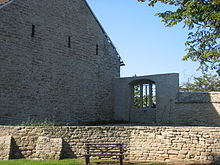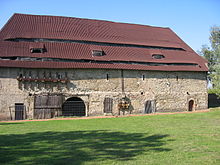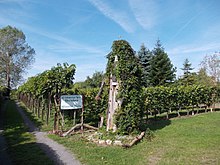Posa Monastery
The former Benedictine monastery Posa , also called Bosau , is located near the city of Zeitz in Saxony-Anhalt and was built on the Slavic Gauburg Puonzowa , which is generally dated to the 9th and 10th centuries. The Gauburg consisted of a main castle on the mountain spur and an outer castle that stretched east of the core castle on the plateau in the direction of Tröglitz .
Founding legend
According to legend, the founding of this Christian institution on Slavic soil was owed to a dream. In it the Virgin Mary appeared to a Slav converted to Christianity and urged him to convey the commandment to the Naumburg Bishop Dietrich I to found the monastery on the Posa mountain spur, on which the former Gauburg stood. Since the bishop did not believe him, he said the prayer that Bishop Dietrich kept quietly every morning to prove it.
history
On the day of the birth of Mary , September 8, 1114, a wooden chapel was first consecrated. In 1115 the construction of a stone monastery church began by Hirsau monks under the direction of Abbot Eck (en) bert. The main altar was consecrated after seven years of construction on September 8, 1121, by Bishop Dietrich of the Virgin Mary. In 1122 the entire monastery was completed and comprised a total of seven altars .
On September 24, 1123, Bishop Dietrich, after Wolfgang Hartmann a member of the noble family of the Reginbodones , was stabbed by a Slavic lay brother at the altar and died three days later of his injuries. As a result of this desecration of the main altar, a new consecration became necessary, which was carried out in September 1124 by the bishops Richwin von Zeitz-Naumburg and Arnold von Merseburg.
After an agreement on May 12, 1212 between Margrave Dietrich von Meißen and the abbot of the Bosau monastery, the latter waived claims against the town and town church of Zwickau in return for compensation of 250 marks .
The monastery was dissolved in 1573 during the Reformation.
Events
The Posa Monastery Culture and Education Association organizes events and tours. The 900th anniversary celebration took place in 2014.
Weinhof
Wine was grown at the monastery until the 18th century. 1998 were u. a. the prime minister planted the first vines in over 200 years. The monastery is currently the northern end of the White Elster Wine Route .
Individual evidence
literature
- Rudolf Drößler: History, role and importance of the Benedictine monastery Bosau (Posa) , in: Rudolf Drößler (Hrsg.): Stadt Zeitz, Vol. 2: The time of the bishops. From the relocation of the bishopric to Naumburg and the return of the bishops to their old residence to the beginning of the Reformation in 1517, Langenweißbach 2009, pp. 130–201, ISBN 978-3-937517-87-2 .
- Jürgen K. Fischer: The Posa Monastery near Zeitz in the 12th century , Elsteraue 2010, ISBN 978-3-00-031453-7 .
- Renate Schipke: Scriptorium and library of the Benedictine monastery Bosau near Zeitz , Wiesbaden 2000, ISBN 3-447-04207-9 .
- Reinhard Schmitt: History and building history of the Posa Monastery , in: Reinhard Schmitt: Contributions to the building history of St. Peter and Paul Cathedral, Moritzburg Castle and Posa Monastery in Zeitz, Halle 2008, pp. 94–144, ISBN 978-3-89812-569 -7 .
Web links
Coordinates: 51 ° 3 '8 " N , 12 ° 9' 15.4" E







